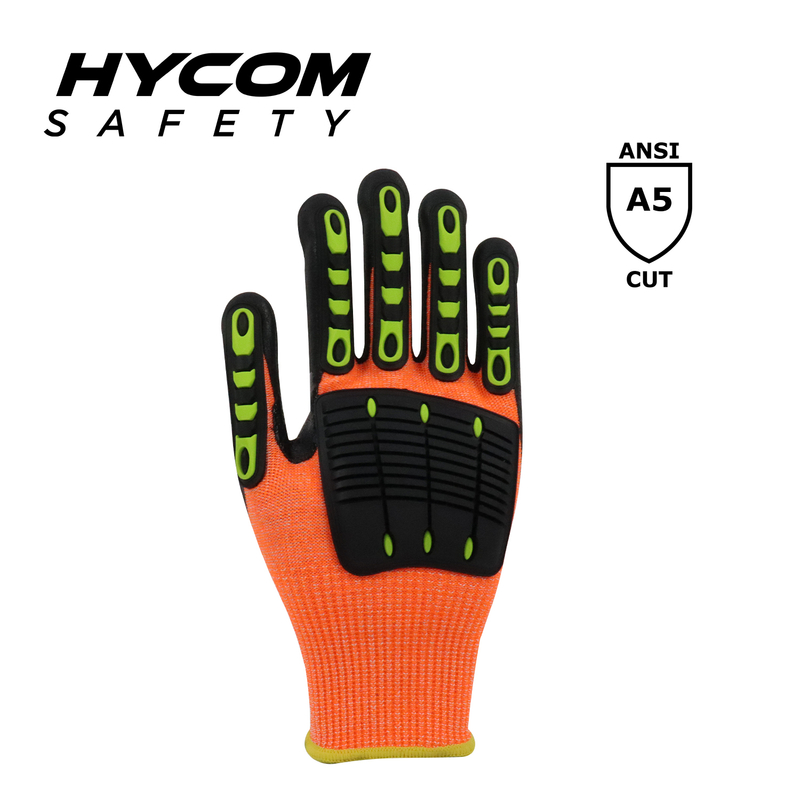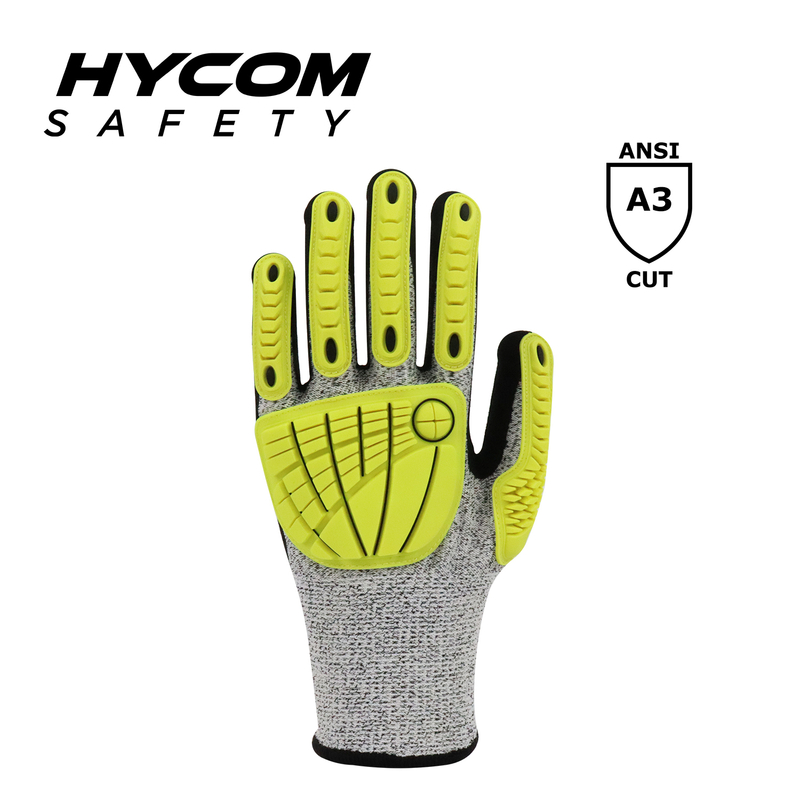Views: 0 Author: Site Editor Publish Time: 2025-10-23 Origin: Site







Level 5 cut resistance refers to the high level of protection offered by specialized gloves designed to safeguard hands from sharp objects and cutting hazards. These gloves are rated based on the ANSI/ISEA 105-2016 standard, which measures their ability to withstand cutting forces between 2,200 and 2,999 grams. Ideal for heavy-duty tasks in industries such as metal fabrication, glass handling, and automotive repair, Level 5 cut-resistant gloves combine advanced materials like HPPE and Kevlar® with innovative designs to ensure both safety and dexterity. Understanding the significance of this protection is crucial for maintaining workplace safety and preventing injuries.
Cut resistance levels help classify gloves by how well they protect hands from sharp objects. In North America, the ANSI/ISEA 105-2016 standard is the key guideline. It uses a 9-level scale from A1 to A9 to rate gloves based on how much cutting force (in grams) they can resist before the blade cuts through.
This standard uses the TDM-100 machine, which tests gloves by applying a steadily increasing load with a blade until it cuts through the material. The higher the level, the greater the protection. For example:
● A1 gloves resist 200 to 499 grams of cutting force.
● A5 gloves resist 2200 to 2999 grams.
● A9 gloves resist 6000 grams or more.
The 2016 update improved accuracy by using only the TDM-100 machine, replacing older tests that had less consistent results. This helps companies select gloves that match their specific safety needs more reliably.
In Europe and other regions, the EN 388:2016 standard governs cut resistance. It uses letters A to F to rate gloves, with F being the highest cut resistance. This standard also employs the TDM-100 machine but uses a different calculation method.
Key differences include:
Feature | ANSI/ISEA 105-2016 | EN 388:2016 |
Scale | A1 to A9 | A to F |
Testing Machine | TDM-100 | TDM-100 |
Measurement Units | Cutting force in grams | Cutting force in Newtons (converted) |
Additional Tests | Focus on cut resistance only | Includes abrasion, tear, puncture resistance |
Because of these differences, a glove rated A5 in ANSI may correspond roughly to an E or F in EN 388, but exact comparisons require manufacturer data.
Understanding both standards helps businesses choose gloves that meet regional regulations and provide adequate protection. For example, workers handling sharp metal sheets in the US might require ANSI A5 gloves, while European counterparts look for EN 388 level E or F gloves.
Both standards aim to improve worker safety by providing clear, test-based performance levels, but knowing which applies helps avoid confusion and ensures the right gloves for the job.
Always check glove labels for both ANSI and EN 388 ratings when sourcing internationally to ensure compliance and optimal protection.

Level 5 cut-resistant gloves offer strong protection against sharp objects, thanks to advanced materials and innovative technologies. These gloves typically use high-performance synthetic fibers such as:
● HPPE (High-Performance Polyethylene): Lightweight and strong, providing excellent cut resistance.
● Aramid fibers (e.g., Kevlar®): Known for heat resistance and durability.
● Steel or fiberglass filaments: Added for extra cut protection.
● Graphene-enhanced yarns (e.g., METALQ®): Graphene is a cutting-edge nanomaterial stronger than steel and diamond, making gloves lighter yet tougher.
Manufacturers often combine these fibers in composite yarns to boost strength and flexibility. The gloves may be knitted or woven to balance protection and dexterity.
Coatings improve grip and durability, including:
● Nitrile: Offers oil and chemical resistance with a strong grip.
● Polyurethane (PU): Provides excellent dexterity and abrasion resistance.
● Latex: Enhances grip in wet conditions.
These coatings help workers handle tools safely without slipping.
Level 5 gloves resist cutting forces between 2,200 and 2,999 grams, making them suitable for heavy-duty tasks. Key features include:
● High cut resistance: Protects against sharp blades, glass, metal edges.
● Durability: Maintains performance over long use, resisting wear and tear.
● Flexibility and dexterity: Allows precise hand movements for detailed work.
● Breathability: Keeps hands comfortable during extended wear.
● Additional protections: Some gloves offer oil-proof, chemical resistance, or heat resistance.
These gloves strike a balance between protection and usability, reducing hand injury risks without sacrificing comfort.
Industries like metal fabrication, glass handling, and automotive repair benefit from these gloves. They enable workers to perform tough jobs confidently and safely.
When choosing Level 5 gloves, check for advanced fiber blends and coatings that match your specific work hazards and comfort needs.
Level 5 cut-resistant gloves provide heavy-duty protection against sharp edges and cutting hazards. Many industries rely on this high level of safety to protect workers’ hands from serious injuries. Key industries include:
● Metal Fabrication: Workers handle sharp metal sheets, cutting tools, and machinery. Level 5 gloves help prevent lacerations during welding, grinding, and sheet metal handling.
● Glass Handling: Glass cutting and installation pose risks from sharp edges and shards. These gloves offer protection and improve grip, reducing accidents.
● Automotive Manufacturing and Repair: Tasks like panel replacement, glass installation, and metal handling require gloves that resist cuts and punctures.
● Construction: Handling sharp tools, nails, and metal components demands reliable cut resistance.
● Food Processing: Cutting meat, fish, and vegetables involves sharp knives. Level 5 gloves protect workers from accidental cuts while maintaining dexterity.
● Aerospace and Warehousing: Handling sharp parts or packaging materials benefits from high cut resistance to avoid injuries.
These industries share common hazards—sharp objects, metal edges, glass shards—that Level 5 gloves are designed to handle.
Certain tasks demand the robust protection Level 5 gloves provide. Examples include:
● Sheet Metal Cutting and Bending: Sharp edges and burrs can easily cut unprotected hands.
● Glass Cutting and Installation: Workers need gloves that resist cuts and provide a secure grip.
● Welding and Grinding: Sparks and metal fragments make cut resistance essential.
● Knife Handling in Food Processing: Protects against accidental blade slips.
● Handling Sharp Tools and Blades: Tasks that involve frequent contact with cutting instruments.
● Assembly Line Work with Sharp Components: Prevents injuries from sharp parts or machinery.
Wearing Level 5 gloves during these tasks reduces injury risk significantly, helping maintain productivity and safety compliance.
Always match glove cut resistance to your specific task hazards to ensure optimal hand protection and comfort on the job.
Choosing the right Level 5 cut-resistant gloves means balancing protection, fit, comfort, and grip. Even the most protective gloves won’t work well if they don’t fit properly or feel uncomfortable. Here are key points to consider:
● Fit: Gloves must match hand size closely. Too tight restricts movement and blood flow, causing fatigue. Too loose reduces dexterity and increases risk of snagging. Check manufacturer sizing charts and try gloves on if possible.
● Comfort: Look for breathable materials and flexible designs. Level 5 gloves often use high-performance fibers combined with coatings. Breathability helps reduce sweat and irritation during long shifts. Stretchable fabrics or ergonomic cuts improve comfort.
● Grip: Secure grip is vital for safety and efficiency. Coatings like nitrile, polyurethane, or latex enhance hold on dry, wet, or oily surfaces. Some gloves feature textured palms or finger tips for extra traction. Grip reduces accidents caused by slipping tools or materials.
Together, these factors ensure gloves protect hands without limiting productivity or causing discomfort.
Beyond cut resistance, extra safety features can make gloves more suitable for specific work environments:
● Chemical Resistance: Some gloves resist oils, solvents, or cleaning agents. This protects skin and extends glove life in harsh chemical settings.
● Heat and Cold Resistance: Tasks near hot surfaces or in cold storage require gloves that shield against temperature extremes while maintaining dexterity.
● Impact Protection: Reinforced knuckles or padded palms absorb shocks and blunt force, reducing injury risks when handling heavy or vibrating tools.
● Electrical Insulation: For electrical work, gloves with dielectric properties prevent shocks and burns.
● Water Resistance: Waterproof or water-repellent gloves keep hands dry in wet conditions, improving comfort and grip.
When selecting gloves, match these features to job hazards. For example, a metal fabricator may prioritize impact protection and chemical resistance, while a food processor might need gloves with excellent dexterity and chemical safety.
Always prioritize glove fit and grip when choosing Level 5 cut-resistant gloves to maximize both safety and worker comfort on the job.

Proper cleaning and storage keep Level 5 cut-resistant gloves effective and long-lasting. Dirt, oils, and chemicals can degrade glove materials, lowering protection. Follow these tips:
● Cleaning: Most Level 5 gloves can be hand washed or machine washed on gentle cycles using mild detergent. Avoid bleach or harsh chemicals that damage fibers and coatings. Rinse thoroughly to remove residue. Air-dry gloves flat or hang them in shade; never use high heat or dryers, which weaken fibers.
● Storage: Store gloves in a cool, dry place away from direct sunlight, heat sources, or chemicals. Avoid folding or crushing gloves to prevent damage to fibers and coatings. Hanging gloves or laying them flat helps maintain shape and performance.
● Avoid contamination: Keep gloves away from sharp objects or abrasive surfaces when not in use to prevent accidental damage.
Regular inspection ensures gloves maintain their protective qualities. Check gloves before and after each use for signs of wear or damage:
● Look for thinning or holes: Areas where fibers are worn thin or punctured reduce cut resistance.
● Check seams and stitching: Loose or broken threads can weaken glove structure.
● Assess fit and elasticity: Gloves that have stretched out or lost flexibility may not protect as well.
● Replace damaged gloves promptly: Do not use gloves with visible damage, as protection is compromised.
Proper care and timely replacement extend glove life and keep workers safe. Even the best Level 5 gloves lose effectiveness over time due to wear and exposure. Establish a routine inspection schedule and train workers to report glove issues immediately.
Implement a glove care and inspection program to maximize protection, reduce costs, and ensure workers always have reliable Level 5 cut-resistant gloves on hand.
Level 5 cut-resistant gloves, using materials like HPPE and Kevlar®, provide protection against sharp objects. They are essential in industries such as metal fabrication and glass handling. Proper fit, comfort, and grip are crucial for effectiveness. Regular cleaning and inspection ensure longevity. Heat Resistant Sleeve Company, Wholesale Cut Resistant Sleeve - HYCOM offers high-quality Level 5 gloves, combining advanced materials and technologies for superior protection. Their products deliver exceptional value by enhancing worker safety and meeting diverse industry needs.
A: Level 5 cut resistance gloves are protective gloves that resist cutting forces between 2,200 and 2,999 grams, offering strong protection against sharp objects for heavy-duty tasks.
A: When selecting Level 5 cut resistance gloves, consider fit, comfort, grip, and any additional safety features like chemical or impact resistance to match your specific work hazards.
A: Level 5 cut resistance gloves are crucial for industries like metal fabrication and glass handling, where they prevent hand injuries and enhance worker safety during tasks involving sharp edges.
A: The price of Level 5 cut resistance gloves varies based on material, brand, and additional features, typically ranging from $10 to $50 per pair.
A: Level 5 cut resistance gloves offer higher protection than lower levels, suitable for tasks with greater cutting hazards, but less than Level 9, which provides the maximum protection.
